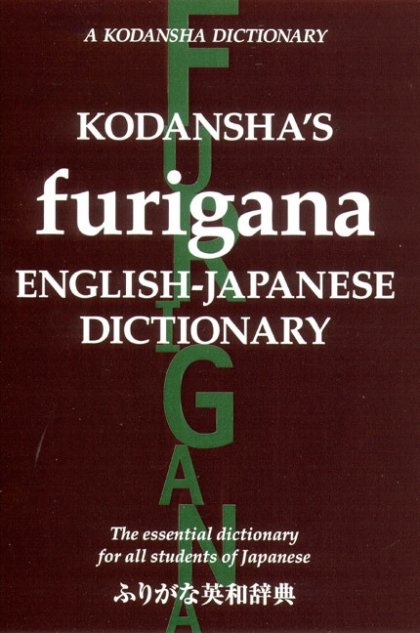Kodansha USA
Kodansha's Furigana English-Japanese Dictionary
Kodansha's Furigana English-Japanese Dictionary
Couldn't load pickup availability

Collapsible content
ABOUT
What is furigana and why is it so important?
Furigana refers to the small kana that are printed above or alongside kanji to show the pronunciation of the Chinese character. With furigana superscripts, the beginner who is familiar with hiragana and katakana is able to read even the most difficult and obscure kanji at a glance. Other dictionaries either provide little or no guide to kanji readings or romanize some or all of the Japanese words and sentences. In the past, romanized dictionaries were of some value to students using textbooks that contained no Japanese script. Now, however, an increasing number of influential curriculums around the world are based on a rationale and methodology that demands the introduction of hiragana and katakana from the earliest stages. Learners and their teachers studying under such curriculums will inevitably feel more comfortable with a dictionary such as Kodansha's Furigana English-Japanese Dictionary, one that shows the pronunciation of kanji with familiar and authentic kana script.
FEATURES
- More than 14,000 entries comprising the most commonly used words in English
- Furigana pronunciation guides added to all kanji
- Semantic and usage differences between Japanese words and expressions explained clearly in English
- Thousands of full-length example sentences illustrate typical usage in natural Japanese
- Idioms, phrases, and common expressions help expand vocabulary and sentence building skills
- Many encyclopedic entries offer useful background information on Japanese history and culture
- Includes many current terms such as artificial intelligence and internet
- Hundreds of scientific and medical terms with full Japanese equivalents
With its sister publication, Kodansha's Furigana Japanese-English Dictionary, this dictionary makes the perfect reference for all students of Japanese. The two books are combined in Kodansha's Furigana Japanese Dictionary.
PRE-ORDER
Secure the best deal by acting fast! Our Pre-Order promo offers unbeatable prices on must-have items. Be quick to lock in the lowest cost before the promo ends.
The best part? You won't be charged until your item is ready to ship. This means you can reserve your product at the best price without immediate payment. Whether you're first in line or just ahead of the crowd, you're making a smart choice. Reserve your item now and enjoy the benefits of being an early buyer, with the added flexibility of delayed payment!
STANDARD, PRIMARY, DM AND VARIANT COVERS
Standard and Primary covers are widely available through general retailers. They often have higher print runs and can be cheaper, especially during sales.
In contrast, Direct Market (DM) and variant covers are primarily sold in comic shops. DM editions tend to have more limited availability and may be more valuable to collectors.
The main differences lie in artwork style, availability, price, and collector appeal. Ultimately, the choice between standard and variant covers depends on personal preference, budget, and individual collecting goals.
PRODUCT TYPES
Comic book enthusiasts have various formats to choose from when collecting their favorite stories.
Here's a brief overview of the main types:
Omnibus
- Large, hardcover collections
- Usually contain complete runs or extensive story arcs
- Typically 800-1000+ pages
- Higher price point, often €100-€150
Oversized Hardcover (OHC)
- Similar dimensions to omnibus, but thinner
- Collect shorter runs or story arcs
- Usually 300-600 pages
- Priced between €30-€50
Hardcover (HC)
- Standard-sized hardcover books
- Collect 6-12 issues typically
- Similar dimensions to single issues, but with a hard cover
- Priced around €25-€35
Trade Paperback (TP)
- Softcover collections
- Standard comic book size
- Usually collect 4-6 issues
- Most affordable option, typically €15-€25
Other Formats
- Absolute Editions: Oversized, deluxe hardcovers (mainly DC Comics)
- Compendiums: Massive paperback collections
- Graphic Novels (OGN/GN): Original stories not previously released as single issues
The choice between these formats often depends on personal preference, budget, and collecting goals. Omnibus and OHC editions offer larger artwork and more content but at a higher price, while TPs provide a more affordable way to collect complete story arcs

